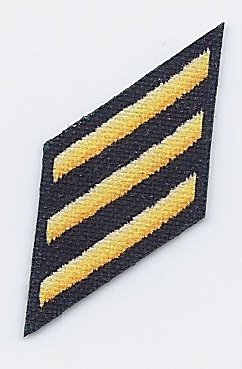Service Stripe Army Regulation
Service Stripe Army Regulation: Everything You Need to Know
Have you ever wondered about the significance of service stripes on an Army uniform? Are you curious about the regulations and policies surrounding these stripes? In this article, we will delve into the world of service stripes as per the Service Stripe Army Regulation.
Understanding the Basics

Service stripes, also known as hash marks, are small embroidered diagonal stripes worn on the lower part of the sleeve of the Army uniform. These stripes are used to commemorate an individual's length of service in the Armed Forces. Each stripe usually represents one year of service, although there may be variations depending on the specific regulation in place.
Gaining a Deeper Insight

The Service Stripe Army Regulation encompasses various aspects related to service stripes, including the rules surrounding their wear, their placement on the uniform, and the eligibility criteria for earning them. Let's delve deeper into some of the key points outlined in this regulation.
1. Eligibility Criteria for Service Stripes
Service stripes are not awarded automatically; they are earned based on an individual's length of service in the Army. Here are some of the eligibility criteria outlined in the Army Regulation:
- Active Duty: Individuals who have completed at least one year of continuous active duty service in any branch of the United States Army are eligible for a service stripe.
- Reserve and National Guard: Reserve and National Guard members are also eligible for service stripes, provided they have completed at least one year of creditable service.
- Break in Service: A break in service is defined as any period during which an individual is not serving on active duty or in a Reserve or National Guard component. For service stripes, breaks in service are not counted towards the cumulative length of service.
2. Placement and Appearance
The Service Stripe Army Regulation also provides guidelines on the proper placement and appearance of service stripes. Here are a few key points to keep in mind:
- Placement: Service stripes are typically placed at a 45-degree angle on the lower part of the left sleeve, four inches above the bottom edge.
- Spacing: The stripes are spaced half an inch apart.
- Color and Material: Service stripes are usually embroidered using gold thread on the Army Combat Uniform (ACU) and the Service Green uniform. However, the exact color and material may vary depending on the uniform type and the specific regulation in place.
3. FAQs About Service Stripes
1. Can I wear service stripes on my dress uniform?
No, service stripes are not authorized on the dress uniform. They are only worn on the Army Combat Uniform (ACU) and the Service Green uniform.
2. Are there any regulations for the appearance of service stripes?
Yes, the Army Regulation outlines specific guidelines for the appearance of service stripes. These guidelines include the placement, spacing, and color of the stripes, which must be adhered to for uniformity.
3. What happens if I have multiple breaks in service?
Any breaks in service are not counted towards the cumulative length of service for earning service stripes. This means that if you have multiple breaks in service, you may need to serve longer than one year to be eligible for a service stripe.
As you can see, service stripes play an important role in recognizing the dedicated service of Army personnel. Understanding the regulations and policies outlined in the Service Stripe Army Regulation is essential for maintaining uniformity and upholding the traditions of the United States Army. So, next time you see an Army uniform adorned with service stripes, you'll have a deeper appreciation for the commitment and dedication that those stripes represent.
Disclaimer: The information in this article is based on general knowledge and does not replace official Army regulations. Please refer to the most recent edition of the Service Stripe Army Regulation for the most accurate and up-to-date information.
Sources:
Army Overseas Service Stripes Regulation - Army Military
 Image Source : armymilitary.net
Image Source : armymilitary.net Army Class A (Dress Green) Service Stripe - Male | USAMM
 Image Source : www.usamilitarymedals.com
Image Source : www.usamilitarymedals.com service army stripe male class green dress
试述美国联邦武装力量制服体系 - 知乎
 Image Source : zhuanlan.zhihu.com
Image Source : zhuanlan.zhihu.com What Does One Stripe On A Police Uniform Mean – SpentApp
 Image Source : spentapp.com
Image Source : spentapp.com How Many Service Stripes Does A Soldier Earn In The Army? – SpentApp
 Image Source : spentapp.com
Image Source : spentapp.com 1:6 Scale US Army Years Of Service Stripe: 9 Years; Service Gre | ONE
 Image Source : onesixthscaleking.com
Image Source : onesixthscaleking.com Army Service Stripes Asu - Gearldine Blodgett
 Image Source : gearldineblodgett.blogspot.com
Image Source : gearldineblodgett.blogspot.com What Regulations Or Policies Cover The Overseas Service Stripe (Combat
 Image Source : www.rallypoint.com
Image Source : www.rallypoint.com service overseas stripe combat bars army regulation regulations policies cover section
Service army stripe male class green dress. What does one stripe on a police uniform mean – spentapp. 1:6 scale us army years of service stripe: 9 years; service gre. Service overseas stripe combat bars army regulation regulations policies cover section. Army class a (dress green) service stripe